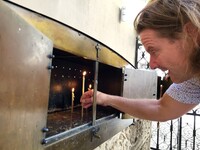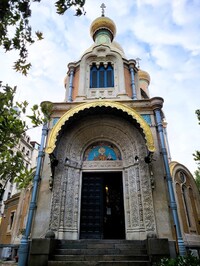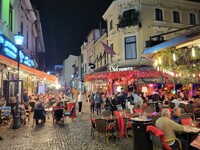By Carmen Zermeno and Tony Winders
At the heart of Bucharest lies Kilometrul Zero, a compass-rose monument outside New St. George Church. Its bronze arcs point toward Romania's historic provinces — Transylvania, Wallachia, Moldova and beyond — reminding travelers that this is not just a city but the center of a story much larger than itself. We began our own journey there, following the lines outward, only to find that they curved back again to a single theme: survival.
In Transylvania survival has taken the shape of myth. Bran Castle, perched on a hilltop framed by thick forest, has been branded "Dracula's Castle." The irony is that Vlad the Impaler, the ruthless 15th-century prince who inspired Bram Stoker's villain, never lived here. During the communist era, Romanians weren't even allowed to read Stoker's book. And yet, Bran became a stage set for legend — a fortress with secret stairways and dark chambers, more powerful for the stories told about it than for its real history.
Back in Bucharest, myth gives way to memory. The city was once nicknamed "Little Paris," its wide boulevards lined with Belle Epoque buildings and its skyline crowned by a replica of the Arc de Triomphe. But the 20th century brought wars, fires, earthquakes and communism. Nicolae Ceausescu's sweeping demolition campaigns flattened historic neighborhoods to build his vision of a new civic center, crowned by the colossal Palace of the Parliament. He never gave the grand speech he intended from its balcony. Instead, decades later, Michael Jackson stood there and mistakenly greeted the crowd with "Hello, Budapest" — a slip Romanians recall with humor and no small measure of irony.
For all its scars, Bucharest never stops rebuilding. Fires once raged through the wooden streets, which were later replaced with cobblestone. Earthquakes toppled towers, only for churches to be raised again on the same foundations. During World War II, Romania itself switched sides — from initially aligning with Germany to joining the Allies when the tides turned. Adaptability has always been a survival skill here, and the city wears that history openly.
What endures are the places where people quietly protected beauty for the future. At Caru' cu Bere, Bucharest's most famous beer hall, the owner once taped over murals to shield them from communist red paint, then revealed them years later in all their color. At Stavropoleos Monastery, stone tablets salvaged from churches destroyed by war or earthquake now line the courtyard, covered in intricate carvings of vines, crosses and inscriptions that whisper of forgotten priests and long-ago congregations. They are fragments of memory, stitched back into the city's fabric.
Bucharest is home to hundreds of churches, and we were struck by the range: the luminous gold interior of St. Nicholas, built with Russian patronage in the early 20th century; St. Anthony, said to be the oldest religious building in the city preserved in its original form; and Stavropoleos, a jewel box of painted frescoes and candlelight.
Outside many of these churches, small shrines flicker with candles — one flame for the living, another for the dead — where worshippers quietly dedicate prayers to loved ones. Each church felt like an island of resilience, rebuilt after fires, shielded during persecution or patiently restored after decades of neglect.
Even our hotel told this story of reinvention. The Marmorosch, once a grand interwar bank, has been reborn as a luxury hotel. By day, the lobby bar gleams beneath a stained-glass ceiling, a temple to art deco glamor. By night, guests slip into The Vault, a subterranean speakeasy carved from the bank's original safe, where walls of brass safe-deposit boxes gleam under chandelier light. It is the perfect metaphor for Bucharest: history not erased but transformed into something alive and surprising.
And then there's the street life, especially in Old Town. Cobblestones replace the city's once-wooden streets. Crowds spill out from cafes and courtyards, clinking glasses of Romanian wine or tuica plum brandy. Musicians play, the air hums with conversation and the six-level Carturesti Carusel bookstore bustles with knowledge. The city may carry scars from fires, wars and political oppression, but its heartbeat is joy.
Perhaps what surprised us most was how approachable it all felt. English is widely spoken, the city is walkable and costs are refreshingly affordable compared to the United States and western Europe. One night we dined under fairy lights at Dracula's Bites & Beats in Old Town, enjoying traditional dishes for less than what a quick lunch might cost in New York, Paris or London. The city is as easy to navigate as it is rich in history — an ideal blend for travelers seeking both depth and comfort.
Bucharest is a city of juxtapositions — French elegance beside Soviet concrete, ruins beside restorations, sacred shrines beside buzzing nightlife. Yet together, those contrasts tell a single story: of resilience, of light rekindled after every darkness, of a city that rebuilds itself again and again while welcoming the world to walk its streets.
WHEN YOU GO
We recommend getting the GetYourGuide app or visiting getyourguide.com/bucharest.


Carmen Zermeno and Tony Winders are freelance writers. To read features by other Creators Syndicate writers and cartoonists, visit the Creators Syndicate website at www.creators.com.
Nightlife thrives in the Old Town area of Bucharest, Romania. Photo courtesy of Tony Winders.







View Comments